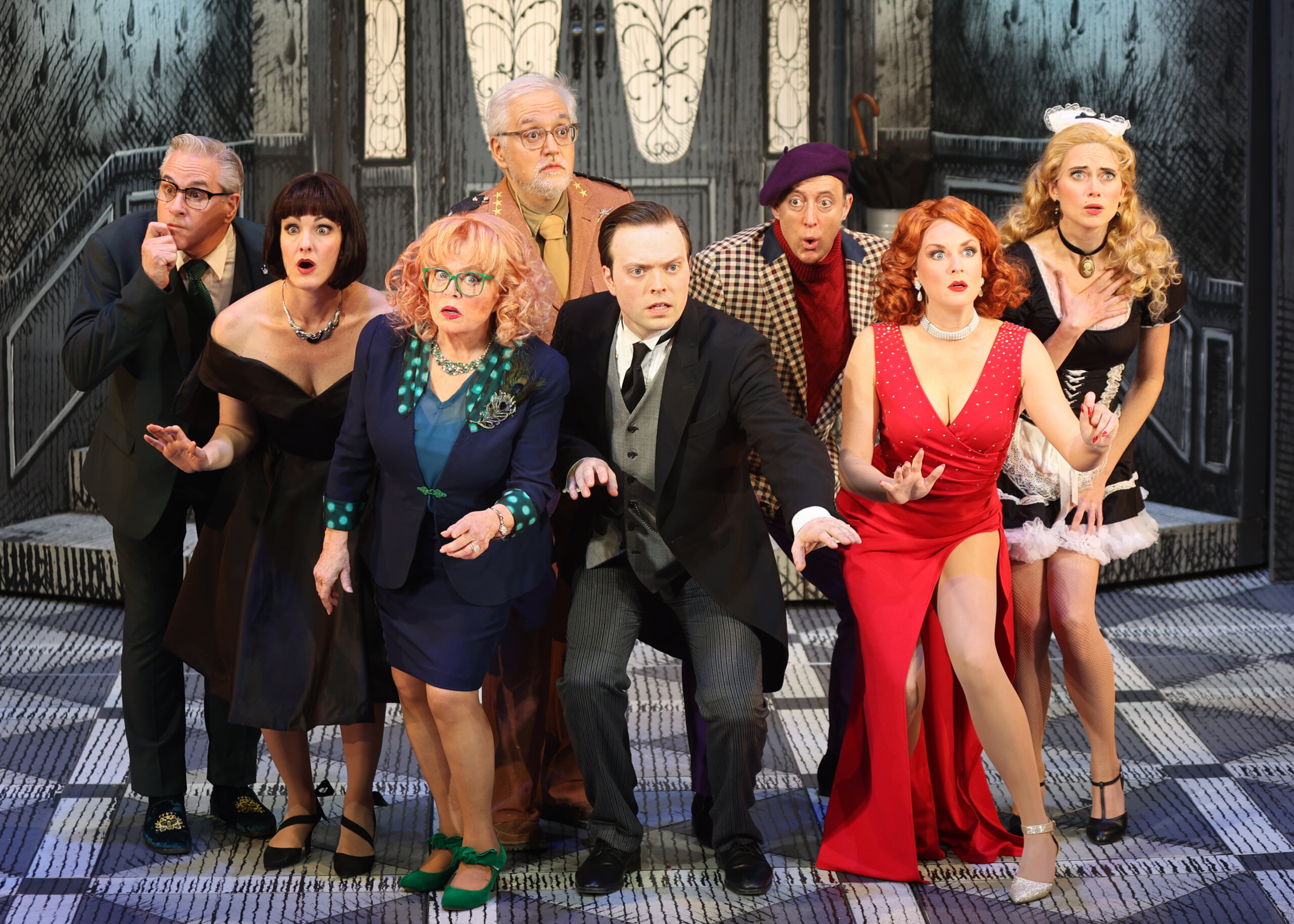Play Review: The Gateway's 'Clue' Is a Fun, Farcical Whodunit

Following on the heels of screen-to-stage comedy The Wedding Singer, The Gateway is upping the antics with an even zanier play originating from a film — or rather, a board game — Clue. Written by Sandy Rustin with screenplay by Jonathan Lynn, this production of Clue is directed by Larry Raben and stars Sally Struthers of All in the Family and Gilmore Girls fame.
Like the film before it, Clue the play takes the characters and setting of the classic whodunit board game and weaves them into a story of 1954 McCarthyism, blackmail and, of course, murder. Set in the mansion of the shady Mr. Boddy, played by Travis Murad Leland, the game’s color-coded players are introduced by the butler of the manor, Wadsworth, portrayed by James Taylor Odom (more on him later). They are locked in for a night playing a murderous game, lest their darkest secrets be revealed.
First to arrive is the iconic Colonel Mustard, portrayed by Christopher Seiler. As the bumbling buffoon of the group, Mustard’s comedy stems from generally not understanding what’s going on around him, but Seiler takes this a step further with his charming eccentricity. A scene that highlights this perfectly is when the players are listening to a private conversation with glasses pressed to the door, and Mustard is just gleefully standing in the middle of the room looking clueless with a glass on each of his ears.
Next up is Mrs. White, portrayed by Jennifer Byrne. As the only character not wearing their assigned color, she dons a black dress instead, her wardrobe could be a hint to her possible “black widow” status — or the decision was made to help her stand out against the whites and grays of the monochromatic set. Out of all the houseguests, Mrs. White is the one most shrouded in mystery — with a dead husband and a history with the manor maid Yvette, played by Traci Bair. The way in which she reacts to things in the play is equally unpredictable, and Byrne plays it expertly.
When Struthers first enters the scene as Mrs. Peacock, the audience roars. With a sweet Southern charm and seemingly high moral standard, it quickly becomes clear that she’s all about keeping appearances, and when the façade fades, there’s no telling what she’ll say. She’s easily the funniest of the players, with most every line and antic met with a burst of laughter. Struthers effortlessly demonstrates why her career has been so successful for decades.
Shortly after introducing Mr. Green, portrayed by David Engel, to the audience, he’s outed as a closeted gay man, which during the concurrent Lavender Scare and Second Red Scare would be a worst-case scenario, were he not hiding an even more shocking secret. Comedy-wise, he’s the accident-prone one, often tripping over himself or having others fall on him. Whether pratfalling or sashaying across the stage, Engel showcases masterful physicality and is a joy to watch throughout the show.
Lastly, we’re introduced to Professor Plum and Miss Scarlet, played by John Long and Emily Brockway respectively. These two are played straighter than their fellow houseguests, while not straying too far from the play’s farce genre. The main source of farce-style humor, however, comes from the breakout character, Wadsworth, played to perfection by James Taylor Odom. Wadsworth easily steals the show, and though it feels odd to call a Clue character who doesn’t originate from the board game the “main character,” he easily is. Odom’s over-the-top portrayal would likely make the great Tim Curry, who played Wadsworth in the film, stand and applaud. Every line is delivered with a puzzling balance of absurdity and plot urgency, and his final scene — which is rumored to vary between showtimes — is a hysterical tour de force.
As mentioned, the set of Clue features a monochromatic esthetic inspired by Tim Burton. It’s split into three large revolving set pieces that transform the stage into several different rooms, with characters spun out of sight like the secret revolving doors frequently found in the mystery genre. At one point in the play, the characters actually move across the mansion via the Clue game board, which is far from the only reference to the original source material.
The play is littered with fun meta references to the board game: characters hurl accusations in the well-known “suspect in the room with the weapon” phrasing, they call out the game’s creators, and they sometimes roll metaphorical dice and hop between rooms like the game pieces being moved across the board. In the play’s final scene, all the answers to the whodunit are answered, and while you can probably suss out the killer if you’re paying attention, keep in mind that this screenplay is farce first, murder mystery second.
If you go into it too seriously, focusing on playing Nancy Drew and piecing together the clues before the big reveal, you’ll be cheating yourself out of enjoying the wacky, Scooby-Doo-esque hijinks and hilarious, cartoonish character portrayals. The Gateway’s Clue is a tightly choreographed, delightfully acted blast for fans of farce, comedy and a little mystery.
Tickets to Clue at The Gateway Playhouse, running through April 16, are available at thegateway.org.



